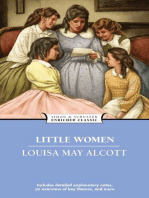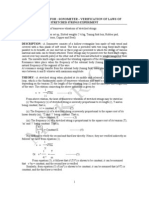Hydraulic Jar
Hydraulic Jar
Uploaded by
Radwan AliCopyright:
Available Formats
Hydraulic Jar
Hydraulic Jar
Uploaded by
Radwan AliOriginal Description:
Original Title
Copyright
Available Formats
Share this document
Did you find this document useful?
Is this content inappropriate?
Copyright:
Available Formats
Hydraulic Jar
Hydraulic Jar
Uploaded by
Radwan AliCopyright:
Available Formats
DST Data Sheets 02/08/2018 13:53 Page 6
Drill Stem Testing
Hydraulic Jar (JAR)
The Hydraulic Jar is used for the purpose of freeing stuck pipe
and tools in the wellbore. This device delivers heavy impact
blows to the test string by storing energy within the tool. In
well test applications the tool is run directly above the Safety
Joint. The Hydraulic Jar is designed to transmit torque and
withstand severe tensile and compressive loads.
Specifications:
Working pressure 15,000 psi/103.42 Mpa
Working temperature (See note 1) 350˚F/175˚C
OD (in/mm) 5” / 127mm
ID (in/mm) 2.25”/57.2mm
Upper thread connection 3 ½” IF
Lower thread connection 3 ½” IF
Tensile strength 350,000lbf/155,600daN
Tensile strength at max working pressure 30,000lbf/13,345daN
Tool length ( in/mm) 113.8in/2890mm
Tool weight (lbs/kg) 525 lbs/ 133 kg
Service condition H2S per Nace MR-01-75
Maximum overpull before the jar fires 80,000lbs/36 tons
Note 1: Working temperature can be increased by changing sealing configuration as follows:
Up to 400°F/204°C – Standard elastomers and premium back-up rings.
Operation:
The Hydraulic Jar is activated by picking up on the test string and holding
tension. The applied tension at the tool forces the oil in the oil chamber to
pass through a flow regulator at a controlled rate. This controlled action
continues until the piston reaches the grooved section of the cylinder bore;
the oil is then rapidly discharged at an uncontrolled rate to the lower section
of the oil chamber. This release of energy together with the energy stored in
the stretched test string causes the mandrel to accelerate upwards until the
mandrel hammer area strikes the anvil stop, delivering high impact force to
the stuck object. The tool is multi-use and can be rapidly re-cocked by
slacking off the work string.
© Expro International Group LTD
HydraulicJar 020818_v4
exprogroup.com
You might also like
- The Subtle Art of Not Giving a F*ck: A Counterintuitive Approach to Living a Good LifeFrom EverandThe Subtle Art of Not Giving a F*ck: A Counterintuitive Approach to Living a Good LifeRating: 4 out of 5 stars4/5 (6026)
- The Gifts of Imperfection: Let Go of Who You Think You're Supposed to Be and Embrace Who You AreFrom EverandThe Gifts of Imperfection: Let Go of Who You Think You're Supposed to Be and Embrace Who You AreRating: 4 out of 5 stars4/5 (1133)
- Never Split the Difference: Negotiating As If Your Life Depended On ItFrom EverandNever Split the Difference: Negotiating As If Your Life Depended On ItRating: 4.5 out of 5 stars4.5/5 (911)
- Grit: The Power of Passion and PerseveranceFrom EverandGrit: The Power of Passion and PerseveranceRating: 4 out of 5 stars4/5 (628)
- Hidden Figures: The American Dream and the Untold Story of the Black Women Mathematicians Who Helped Win the Space RaceFrom EverandHidden Figures: The American Dream and the Untold Story of the Black Women Mathematicians Who Helped Win the Space RaceRating: 4 out of 5 stars4/5 (938)
- Shoe Dog: A Memoir by the Creator of NikeFrom EverandShoe Dog: A Memoir by the Creator of NikeRating: 4.5 out of 5 stars4.5/5 (548)
- The Hard Thing About Hard Things: Building a Business When There Are No Easy AnswersFrom EverandThe Hard Thing About Hard Things: Building a Business When There Are No Easy AnswersRating: 4.5 out of 5 stars4.5/5 (359)
- Lessons 4-5 - Waves On A String Remote LabDocument5 pagesLessons 4-5 - Waves On A String Remote LabNia Nelson57% (7)
- Her Body and Other Parties: StoriesFrom EverandHer Body and Other Parties: StoriesRating: 4 out of 5 stars4/5 (831)
- Elon Musk: Tesla, SpaceX, and the Quest for a Fantastic FutureFrom EverandElon Musk: Tesla, SpaceX, and the Quest for a Fantastic FutureRating: 4.5 out of 5 stars4.5/5 (481)
- The Emperor of All Maladies: A Biography of CancerFrom EverandThe Emperor of All Maladies: A Biography of CancerRating: 4.5 out of 5 stars4.5/5 (275)
- The Yellow House: A Memoir (2019 National Book Award Winner)From EverandThe Yellow House: A Memoir (2019 National Book Award Winner)Rating: 4 out of 5 stars4/5 (99)
- The Little Book of Hygge: Danish Secrets to Happy LivingFrom EverandThe Little Book of Hygge: Danish Secrets to Happy LivingRating: 3.5 out of 5 stars3.5/5 (434)
- Devil in the Grove: Thurgood Marshall, the Groveland Boys, and the Dawn of a New AmericaFrom EverandDevil in the Grove: Thurgood Marshall, the Groveland Boys, and the Dawn of a New AmericaRating: 4.5 out of 5 stars4.5/5 (273)
- The World Is Flat 3.0: A Brief History of the Twenty-first CenturyFrom EverandThe World Is Flat 3.0: A Brief History of the Twenty-first CenturyRating: 3.5 out of 5 stars3.5/5 (2283)
- The Sympathizer: A Novel (Pulitzer Prize for Fiction)From EverandThe Sympathizer: A Novel (Pulitzer Prize for Fiction)Rating: 4.5 out of 5 stars4.5/5 (125)
- Team of Rivals: The Political Genius of Abraham LincolnFrom EverandTeam of Rivals: The Political Genius of Abraham LincolnRating: 4.5 out of 5 stars4.5/5 (235)
- A Heartbreaking Work Of Staggering Genius: A Memoir Based on a True StoryFrom EverandA Heartbreaking Work Of Staggering Genius: A Memoir Based on a True StoryRating: 3.5 out of 5 stars3.5/5 (233)
- On Fire: The (Burning) Case for a Green New DealFrom EverandOn Fire: The (Burning) Case for a Green New DealRating: 4 out of 5 stars4/5 (75)
- The Unwinding: An Inner History of the New AmericaFrom EverandThe Unwinding: An Inner History of the New AmericaRating: 4 out of 5 stars4/5 (45)
- Design of Tension MembersDocument26 pagesDesign of Tension MembersLily100% (1)
- Ghadames BasinDocument8 pagesGhadames BasinRadwan Ali100% (1)
- Fload HeadDocument2 pagesFload HeadRadwan AliNo ratings yet
- Atshan Field 2Document10 pagesAtshan Field 2Radwan AliNo ratings yet
- Alkenes Detection From Drill Bit Metamorphism and Real-Time Geochemical Elemental Analysis On Drill Cuttings Aids Drilling Optimization and GeosteerDocument6 pagesAlkenes Detection From Drill Bit Metamorphism and Real-Time Geochemical Elemental Analysis On Drill Cuttings Aids Drilling Optimization and GeosteerRadwan AliNo ratings yet
- 1 - Field Development Planning - Intro + FDP TeamDocument53 pages1 - Field Development Planning - Intro + FDP TeamRadwan AliNo ratings yet
- Intro. To Geology and ReservoirDocument82 pagesIntro. To Geology and ReservoirRadwan AliNo ratings yet
- Corporate Office: Aakash Tower, 8, Pusa Road, New Delhi-110005Document13 pagesCorporate Office: Aakash Tower, 8, Pusa Road, New Delhi-110005studymaterial23072006No ratings yet
- Cambridge International AS & A Level Mathematics: Mechanics Practice PaperDocument9 pagesCambridge International AS & A Level Mathematics: Mechanics Practice Paperahmadaitzaz340No ratings yet
- 03 Bronze 3 - M1 EdexcelDocument14 pages03 Bronze 3 - M1 Edexcelfaiha abdulla ageelNo ratings yet
- AISC2005-Anchor BoltDocument9 pagesAISC2005-Anchor Boltnmtam.sdh20No ratings yet
- CTM 15Document32 pagesCTM 15vaishnavisonkatale425No ratings yet
- Design of Structures 3 (2+1)Document9 pagesDesign of Structures 3 (2+1)Wilfharry billyNo ratings yet
- Newtons Laws of MotionDocument7 pagesNewtons Laws of MotionJanaka PriyalalNo ratings yet
- PULLEY Systems4Document9 pagesPULLEY Systems4rameshNo ratings yet
- 9709 s15 QP 43Document4 pages9709 s15 QP 43Syakir AkeNo ratings yet
- Cable TrackingDocument6 pagesCable TrackingjoaquicNo ratings yet
- Mechanical System Isolation:: Free-Body DiagramDocument33 pagesMechanical System Isolation:: Free-Body DiagramChristian DelfinNo ratings yet
- Me Mechanics Notes - Dynamics - Connected ParticlesDocument5 pagesMe Mechanics Notes - Dynamics - Connected ParticlesouwshiNo ratings yet
- Modelling Cables and RopesDocument14 pagesModelling Cables and RopesAjivakkom Vivekanandan50% (2)
- Question Sheet2 PDFDocument15 pagesQuestion Sheet2 PDFSaumyak RajNo ratings yet
- Class XI Laws of Motion Practice QuestionsDocument2 pagesClass XI Laws of Motion Practice Questionsroythomasc100% (6)
- 4.2 Dynamics Part Two - KeyDocument4 pages4.2 Dynamics Part Two - KeyAli Ali AliNo ratings yet
- 5 Limit State Design Tension MembersDocument61 pages5 Limit State Design Tension MembersMAKWANA GEET DEVENDRABHAINo ratings yet
- Engineering Mechanics Refresher PDFDocument2 pagesEngineering Mechanics Refresher PDFYgan Ramir AbecillaNo ratings yet
- 9709 s13 QP 42Document4 pages9709 s13 QP 42Irtiza HussainNo ratings yet
- Physics Paper O LevelDocument18 pagesPhysics Paper O Levelwackmalik100% (1)
- Tubing Anchor CatcherDocument13 pagesTubing Anchor CatcherMohamed Abd El-MoniemNo ratings yet
- Sonometer - Laws of Stretched Strings - 1Document2 pagesSonometer - Laws of Stretched Strings - 1DR.P.V.Kanaka Rao67% (18)
- Science 1 NotesDocument14 pagesScience 1 NotesArshein Mae CabradillaNo ratings yet
- Physics (Jee Advanced)Document8 pagesPhysics (Jee Advanced)PranavMachingal100% (1)
- Solution Manual For Mechanics of MateriaDocument54 pagesSolution Manual For Mechanics of MateriaJericho CunananNo ratings yet
- Phys11 c04 4 3Document6 pagesPhys11 c04 4 3api-237070241No ratings yet
- Tunnel Base-1700Document24 pagesTunnel Base-1700m.hgag13No ratings yet
- MAE 241 - Final ExamDocument8 pagesMAE 241 - Final ExamDarran CairnsNo ratings yet












































































